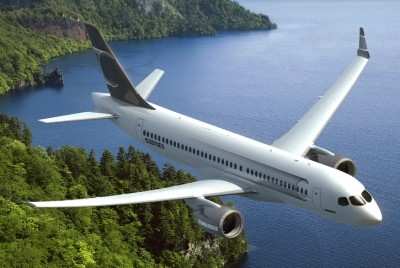20-year Business Aircraft Market Forecast Predicts 26,000
Deliveries Through 2029
 Bombardier Aerospace released its
annual aircraft market forecasts for the business and commercial
aircraft markets Tuesday at the Farnborough International Air
Show.
Bombardier Aerospace released its
annual aircraft market forecasts for the business and commercial
aircraft markets Tuesday at the Farnborough International Air
Show.
While both the business aircraft and commercial aircraft markets
were affected by the recession, business indicators show
improvement and there are positive signs for the global industry in
2010. The company believes that the market fundamentals are strong
in the long term and that there is reason to be cautiously
optimistic that demand for new commercial aircraft and business
jets will return. It is expected that emerging market opportunities
in China, India and other developing regions should provide a
powerful impetus to the global industry's recovery. As a leader in
commercial and business aviation, Bombardier is confident about the
industry's future and continues to invest in new programs, such as
the Global Vision flight deck and the Learjet 85, CRJ1000 NextGen
and CSeries aircraft.
In this year's forecast, Bombardier Aerospace presented for the
first time a 20-year outlook for the business aircraft industry.
The company says the forecast's new time horizon reflects it's
long-term vision of the business jet market and better matches the
lifecycle of aircraft programs.

Bombardier Lear 40XR
In the 20-year period from 2010 to 2029, the Bombardier Business
Aircraft Market Forecast predicts there will be a return to growth
with business jet manufacturers delivering a total of 26,000
business jets in all segments in which Bombardier competes (from
Light to Large categories). The forecast 26,000 deliveries over the
20-year period represent total revenues of approximately $661
billion for the industry, of which 10,500 deliveries worth $254
billion are anticipated in the period from 2010 to 2019, and 15,500
deliveries worth $407 billion in the period from 2020 to 2029.
Despite a continued backdrop of global economic challenges,
Bombardier believes the long-term market drivers of growth for the
business jet industry remain solid. Toward the second half of
calendar year 2009, these indicators began showing signs that this
market segment was stabilizing. The market drivers include wealth
creation, above average economic growth in emerging markets,
increased globalization of trade, significant replacement demand
potential, new aircraft programs and demand from non-traditional
offerings. However, while there are signs of stabilization in the
business aircraft industry, historically a lag exists between
economic recovery and its positive impact on revenues.
With the fundamentals of the business jet industry expected to
remain positive in the long term, Bombardier will maintain its
focus on strengthening its market leadership position by continuing
to invest in its in-development Learjet 85 aircraft and Global
Vision flight deck programs. With a strong product line and
dedication to customer support and product development, Bombardier
plans to benefit from the expected long-term market growth and to
lead the way in the business jet market.
According to the Bombardier Commercial Aircraft Market Forecast,
demand for 20- to 149-seat commercial aircraft is expected to reach
12,800 new aircraft in the 20-year period from 2010 to 2029. This
is an increase of 400 units compared to last year's forecast. The
outlook for delivery demand is valued at approximately $612
billion.

Bombardier C300 Artist's Rendering
Demand for new commercial aircraft is directly related to the
strength of the global economy, and in this 20-year forecast, the
Gross Domestic Product (GDP) growth rate forecast has increased to
3.2 per cent from 2.98 per cent last year.
With above average economic growth forecasts, developing markets
will present sizeable opportunities for new aircraft sales. As
such, over the next 20 years, commercial aircraft demand from
markets outside of North America and Europe is expected to increase
considerably. Illustratively, it is estimated that China's fleet of
20- to 149-seat commercial aircraft will become the third largest,
closely behind Europe and the U.S.
Within the aviation industry, concern about the impact on the
environment is influencing decisions being made at all levels.
Building on its strong track record of technological progress and
innovation, the aerospace industry has formally committed to a
future of carbon-neutral growth by 2020 and increased environmental
sustainability.
In the drive to achieve a sustainable future, Bombardier says
it is proactive in addressing environmental concerns. As a
leading aircraft manufacturer, The company says it remains focused
on developing and employing technologies that contribute to the
industry-wide efforts regarding emissions reduction. Additionally,
in its commitment to be a socially responsible corporate citizen,
Bombardier says it is determined to address environmental
challenges at all stages of the product lifecycle, from design to
end of life. In that regard, Bombardier is the first OEM to earn
accreditation from the Aircraft Fleet Recycling Association (AFRA).
AFRA is recognized worldwide for its leadership in promoting best
practices for salvaging and recycling components from aging
aircraft during disassembly.
 ANN's Daily Aero-Linx (05.06.25)
ANN's Daily Aero-Linx (05.06.25) ANN's Daily Aero-Term (05.06.25): Ultrahigh Frequency (UHF)
ANN's Daily Aero-Term (05.06.25): Ultrahigh Frequency (UHF) ANN FAQ: Q&A 101
ANN FAQ: Q&A 101 Classic Aero-TV: Virtual Reality Painting--PPG Leverages Technology for Training
Classic Aero-TV: Virtual Reality Painting--PPG Leverages Technology for Training Airborne 05.02.25: Joby Crewed Milestone, Diamond Club, Canadian Pilot Insurance
Airborne 05.02.25: Joby Crewed Milestone, Diamond Club, Canadian Pilot Insurance




